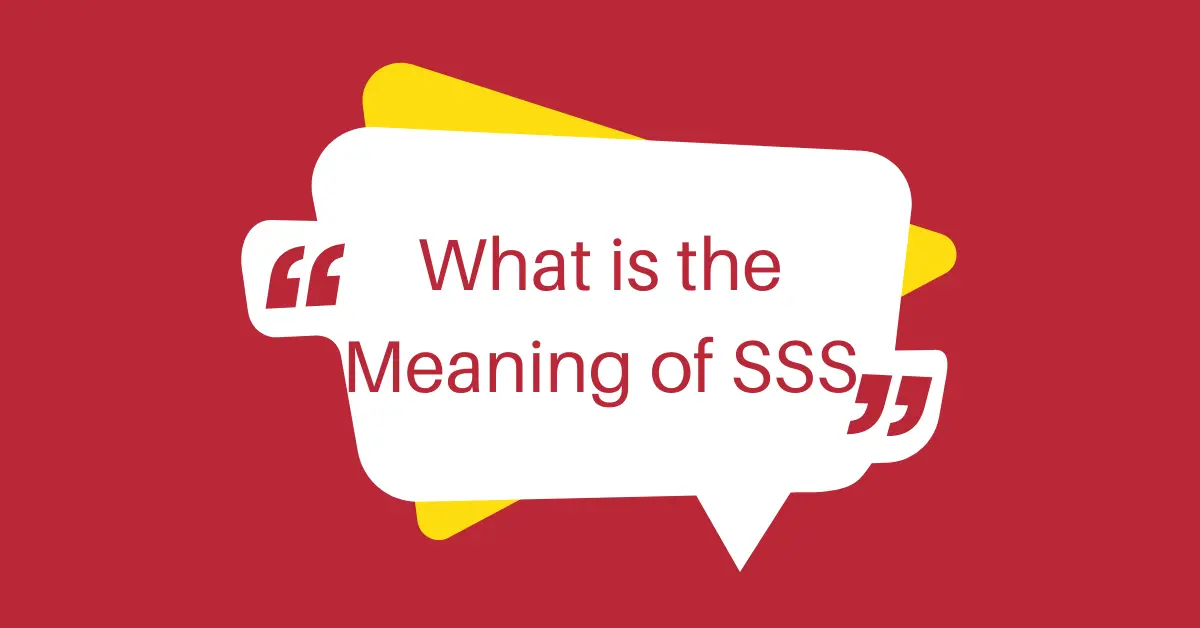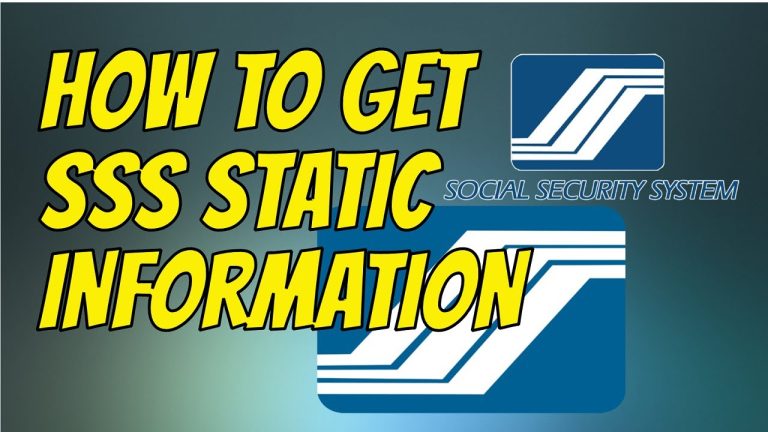What is the Meaning of SSS – Social Security System
The Social Security System (SSS) in the Philippines is a government-managed insurance program that provides a wide range of benefits to its members, including loans, pensions, and maternity and sick leave benefits. To become a member of the SSS, Filipinos need to pay their monthly contributions and fulfill all the requirements set by the SSS. This article delves into the functioning of the SSS and the benefits it offers.
Upon starting employment in the Philippines, individuals are automatically enrolled in the SSS. What is the Meaning of SSS – Social Security System Their monthly contributions are deducted from their salary by their employers, who are responsible for remitting these payments.
Moreover, individuals have the option to make voluntary contributions to their SSS accounts. This can be advantageous for those seeking to enhance their benefits or for self-employed individuals. Voluntary contributions are paid directly to the SSS.
It is important to note that the SSS provides various benefits to its members. These benefits include but are not limited to retirement, disability, death, funeral, sickness, maternity, and unemployment benefits. The amount of benefits received is determined by the member’s total contributions and the specific conditions outlined by the SSS.
In conclusion, the Social Security System in the Philippines is an insurance program administered by the government, offering a wide array of benefits to its members. Through mandatory and voluntary contributions, individuals can avail themselves of the benefits provided by the SSS, such as loans, pensions, and maternity and sick leave benefits.

Overview
The situation described reflects the reality for many Filipinos, as they heavily rely on their active income jobs and may not have investments or passive income to rely on after retirement. The ideal retirement age for Filipino laborers is typically around 60 years old, although some may choose to extend it up to 65 years of age.
Upon retirement, some fortunate individuals receive a substantial amount of retirement pay from their employers, while others may have to depend on their last pay or meager savings. Recognizing the need to support its citizens, the government has established a Social Insurance Program to provide a safety net for each Filipino member and their beneficiaries.
As a laborer in the Philippines, your employer would likely require you to become a member of the Social Security System (SSS). The SSS is an insurance program created by the government that offers a wide range of coverage. It includes benefits for Sickness, Maternity, Disability, Funeral, Death, and Retirement. However, the program’s scope is not limited to these areas alone, as the SSS also provides loans for various purposes, such as wages, housing, business, and education.
What is SSS?
SSS is an acronym for Social Security System. It is a government institution that manages the social insurance program in the Philippines.
Purpose of SSS
The statement you provided seems to be describing the benefits of the Social Security System (SSS) in the Philippines. The SSS is a government agency that provides social insurance, including retirement, disability, sickness, maternity, funeral, and death benefits to its members. It aims to allow every Filipino worker to secure their future after retirement or separation from work due to valid circumstances.
The SSS provides various cash benefits to its members. Here’s a breakdown of the benefits:
- Sickness Benefit: This benefit provides cash assistance to a member who is unable to work due to an illness or injury. It covers a specific period of sickness, as certified by a licensed physician.
- Maternity Benefit: Female members are entitled to maternity benefits, which provide cash assistance during their maternity leave. The benefit includes a daily cash allowance for a specific number of days, depending on the type of delivery (normal or caesarian).
- Disability Benefit: If a member becomes permanently or temporarily disabled due to an illness or injury, they may be eligible for disability benefits. The benefit amount depends on the degree of disability.
- Funeral Benefit: In the unfortunate event of a member’s death, the SSS provides funeral benefits to the beneficiaries. This benefit helps cover the funeral expenses of the deceased member.
- Death Benefit: The SSS offers death benefits to the qualified beneficiaries of a deceased member. The benefit is a lump sum amount given to the beneficiaries of the deceased member.
- Retirement Benefit: Members who have reached the retirement age can avail themselves of retirement benefits. The amount of benefit depends on the member’s total contributions and the number of credited years of service.
It’s important to note that specific eligibility requirements, contribution obligations, and other factors may apply to each benefit. Members are advised to regularly contribute to the SSS and comply with the requirements to ensure their entitlement to these benefits.
About this Agency
The concept of the Social Security System (SSS) was initiated in 1948 when Former President Manuel Roxas signed a bill to establish a social security program in the Philippines. The purpose of this program was to provide financial protection for Filipino wage earners and low-paid workers. Subsequently, in 1954, the government passed the Social Security Act, also known as the Social Security Law.
In 1957, the SSS officially commenced its operations following the proclamation of the Social Security Act of 1954. Over the years, the SSS grew stronger and more dedicated to its mission. In 2018, a new Social Security Act was enacted, which was further modified by Republic Act No. 11199. This modification aimed to enhance the SSS system and ensure a better life for every Filipino. The SSS adopted the motto “work, save, invest, and prosper” to embody its goals.
The Social Security System (SSS) offers three main types of membership: Compulsory, Self-Employed, and Voluntary. For employed SSS members, the contribution is deducted compulsorily from their salary. Both the employee and the employer share the contribution. The monthly SSS contribution is calculated as 11% of the member’s monthly salary, with 7.37% of this 11% being shouldered by the employer.
Functions and Responsibility
The Social Security System is there for Filipino people to implement programs for private and informal sector workers.
SSS Benefits
Sickness-
The term “paraphrase” is not recognized as a commonly used term or concept. It appears to be a typographical error or a term specific to a certain context or organization. If you meant to refer to a different term or provide more context, please let me know and I’ll be happy to assist you further.
Maternity-
“This benefit is specifically for female members of the SSS. If you are unable to work due to childbirth or miscarriage, the SSS will provide a cash allowance grant. The amount of the benefit will be calculated by multiplying your daily salary by 60 days (for normal delivery or miscarriage) or 78 days (for caesarian section).”
Disability-
This is for permanently disabled members. Those who became partially disabled due to physical and mental damage.
Retirement-
The Social Security System (SSS) provides benefits to its members in the Philippines. After you retire from work, SSS offers two options: a monthly pension or a lump sum amount.
To qualify for a lifetime monthly pension, a member must have paid at least 120 months of contributions to the SSS and must have already separated or retired from work at the age of 60 or later. This means that if you meet these criteria, you will receive a monthly pension for the rest of your life.
On the other hand, if you have failed to make at least 120 monthly contributions to the SSS, you will not qualify for the lifetime monthly pension. However, you may still be eligible for a one-time cash grant known as a lump sum. The lump sum is not a lifetime pension, but rather a single payment that you will receive upon retirement.
It’s important to note that the specific amounts for the monthly pension or the lump sum are determined by the SSS based on various factors such as the member’s total contributions and average monthly salary. These amounts can vary from person to person.
If you have more questions or need further information about SSS benefits, it is recommended to directly contact the Social Security System or visit their official website for the most accurate and up-to-date details.
Death Benefit-
The deceased member’s legitimate dependent (spouse) will be eligible to receive either a monthly pension or a lump sum. However, this benefit will be suspended if the dependent decides to remarry. In the case of the deceased member being single, the secondary beneficiaries entitled to receive the benefit would be their parents.
Funeral-
The family of the deceased pensioner will receive a funeral grant worth P20,000 – P40,000.
Types of Membership
Who are considered voluntary members?
If you are a non-working spouse of an SSS member, you have the option to register under the voluntary membership category. This allows you to avail of SSS benefits and contribute to the SSS program even if you do not have your employment or source of income.
If you were previously an SSS member with an “employed” status and you have already separated from work, you can continue your SSS membership by shifting to voluntary membership. This will enable you to maintain your contributions and eligibility for SSS benefits.
Similarly, if you were a previous SSS member who chose to become self-employed and subsequently resigned from your job, you can transition to voluntary membership. By doing so, you can continue your SSS contributions and maintain your entitlement to SSS benefits as a self-employed individual.
In both cases, shifting to voluntary membership allows you to retain your SSS coverage and continue contributing to the program, ensuring that you can avail of various benefits and services offered by the Social Security System.
Who is considered self-employed?
It seems like you’re referring to the qualifications and criteria for self-employed individuals who wish to change their membership status to self-employed with the Social Security System (SSS). Based on the information you provided, here are the key points:
- Employment Status: The individual should not be working as a regular employee for a company.
- Age Requirement: The individual should be below 60 years old.
- Minimum Earnings: If you are self-employed and want to change your SSS membership status to self-employed, you must be earning at least P1,000.00 (Philippine pesos) per month.
- Business Ownership: Individuals who have their businesses, including partners or single proprietors, are considered self-employed. Additionally, certain professionals such as actors, actresses, directors, news correspondents, content writers, professional athletes, coaches, trainers, and others can also be categorized as self-employed.
It’s important to note that this information is based on the details you provided and the general understanding of self-employment qualifications with the SSS. However, SSS policies and requirements may change over time, so it’s always recommended to verify the most up-to-date information directly from the SSS or their official website.
Frequently Asked Questions
Here are some common questions Filipinos have about SSS for your reference:
1. How to become a member of SSS?
You can apply for an SSS membership at any branch near you or sign up for an application online. When applying for SSS on any SSS branch you need to bring proof of your identification, it can be your ID or Birth Certificate. Fill out the registration form.
After completing the registration form the designated staff will give you an E-1 form where you need to put your Name, Address, and possible Beneficiaries. This paper will also be imprinted with your unique SSS Number.
2. What exactly is My.SSS?
Don’t get confused, My.SSS is an online website where members can access all information about their records. As an SSS member, you need to sign up for an account, then you will have all the access to your SSS membership.
Having an online account can make your SSS transactions easier and faster like downloading documents and forms, checking and verifying your contributions, requesting loans, etc.
3. Why do I need to sign up for an SSS account online if I can just transact personally?
Since fraud is scattered everywhere, data secured online platform for SSS members is the best move. Upon registering an account in My.SSS, you will see how the process could be so strict. In short, no one can sign up for an account using your name and details.
Why? Because the website requires a lot of requirements that scammers and hackers can’t provide. Having the complete name, address, and SSS number wouldn’t be enough to make an account.
4. Who is eligible to register at My.SSS?
- Regular employers
- Employed members who have been reported for coverage by their employer
- Self-paying members such as self-employed people, nonworking spouses, Overseas Filipino Workers (OFWs), and other volunteers.
- Members who have contributed for at least one (1) month
- Domestic Workers
5. How can I apply for an SSS Loan?
The first and most important requirement to avail of an SSS salary loan is a minimum of a 36-month contribution. In the past decades, you can only apply for a loan by visiting an SSS branch personally. But since the agency is pushing people to use a more convenient and safe transaction, especially during this pandemic, you can just request a loan online.
6. What are the loans and benefits available for SSS members?
SSS provides a wide range of loans and benefits for its members here are some:
- Salary Loan
- Calamity Loan
- Pension Loan
- Maternity Leave Benefit
- Sick Leave Benefit
7. Can I start receiving an SSS pension while currently employed?
Technically speaking, you can be employed and start receiving a pension, but you must be at least 65 during that time. The optional retirement for an employee is 60 years old, while the technical retirement is 65 years old.
However with the regulations and policies of companies here in the Philippines, the maximum age for employed laborers is 65 before they will be subjected to compulsory retirement. So it will be impossible for many to start receiving a pension while still working for a company.
Summary
The Social Security System (SSS) in the Philippines is indeed a popular option for individuals with small salaries and earnings who are looking for life insurance coverage. While it may not be the best life insurance option in the country, it provides valuable assistance to different types of laborers and employees.
One advantage of SSS is that for employed members, the employer shares a portion of the contribution. This means that even if the employee’s salary is low, the monthly SSS contribution is not a significant burden on their finances. What is the Meaning of SSS – Social Security System This makes it an accessible and affordable option for individuals with limited income.
Additionally, the qualification process for becoming a member of SSS is relatively straightforward. As long as you can meet the requirements and fulfill your monthly contribution obligations, you can become a member. This inclusivity allows more people to avail themselves of the benefits provided by the SSS.



